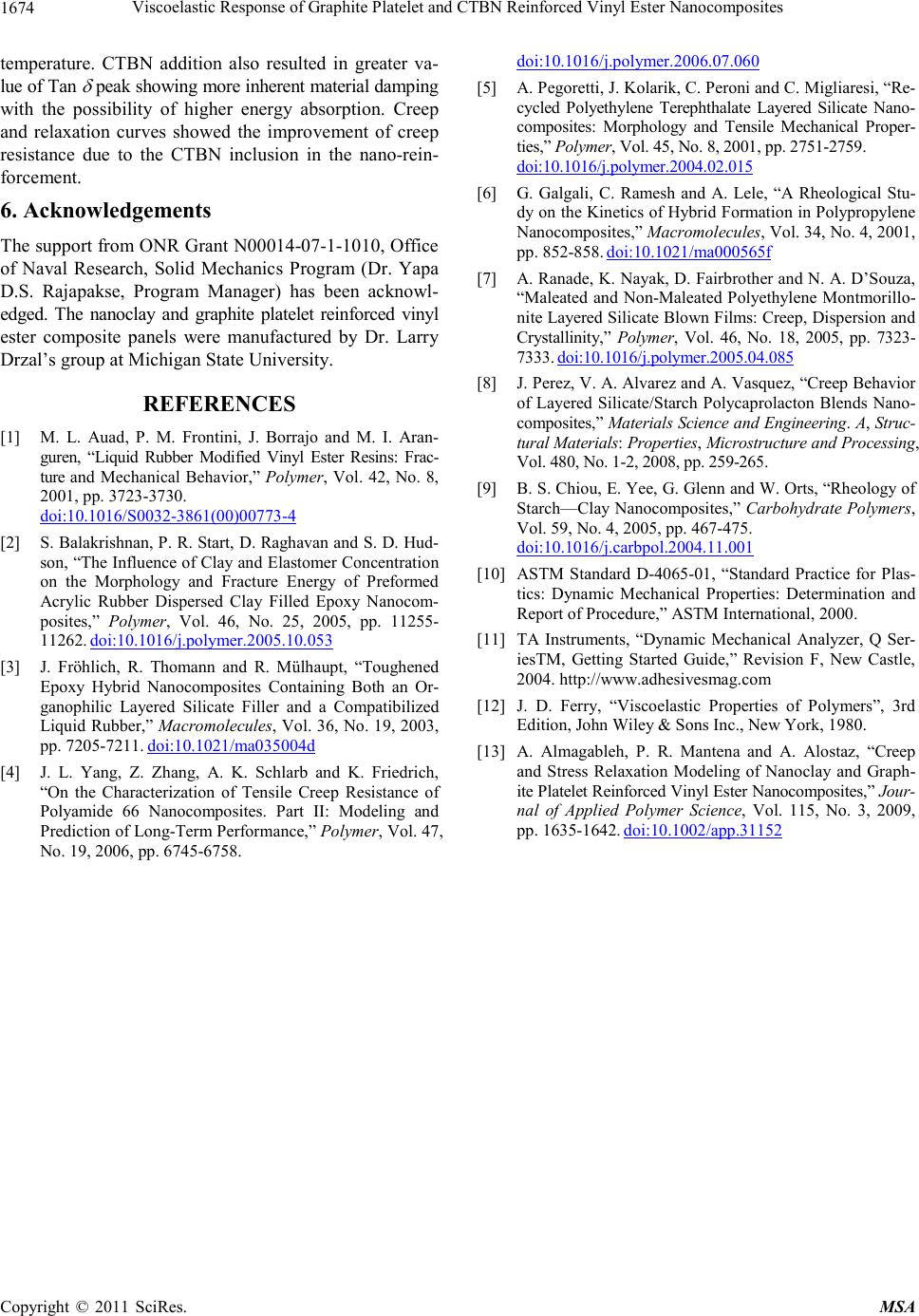
Viscoelastic Response of Graphite Platelet and CTBN Reinforced Vinyl Ester Nanocomposites
Copyright © 2011 SciRes. MSA
1674
temperature. CTBN addition also resulted in greater va-
lue of Tan
peak showing more inherent material damping
with the possibility of higher energy absorption. Creep
and relaxation curves showed the improvement of creep
resistance due to the CTBN inclusion in the nano-rein-
forcement.
6. Acknowledgements
The support from ONR Grant N00014-07-1-1010, Office
of Naval Research, Solid Mechanics Program (Dr. Yapa
D.S. Rajapakse, Program Manager) has been acknowl-
edged. The nanoclay and graphite platelet reinforced vinyl
ester composite panels were manufactured by Dr. Larry
Drzal’s group at Michigan State University.
REFERENCES
[1] M. L. Auad, P. M. Frontini, J. Borrajo and M. I. Aran-
guren, “Liquid Rubber Modified Vinyl Ester Resins: Frac-
ture and Mechanical Behavior,” Polymer, Vol. 42, No. 8,
2001, pp. 3723-3730.
doi:10.1016/S0032-3861(00)00773-4
[2] S. Balakrishnan, P. R. Start, D. Raghavan and S. D. Hud-
son, “The Influence of Clay and Elastomer Concentration
on the Morphology and Fracture Energy of Preformed
Acrylic Rubber Dispersed Clay Filled Epoxy Nanocom-
posites,” Polymer, Vol. 46, No. 25, 2005, pp. 11255-
11262. doi:10.1016/j.polymer.2005.10.053
[3] J. Fröhlich, R. Thomann and R. Mülhaupt, “Toughened
Epoxy Hybrid Nanocomposites Containing Both an Or-
ganophilic Layered Silicate Filler and a Compatibilized
Liquid Rubber,” Macromolecules, Vol. 36, No. 19, 2003,
pp. 7205-7211. doi:10.1021/ma035004d
[4] J. L. Yang, Z. Zhang, A. K. Schlarb and K. Friedrich,
“On the Characterization of Tensile Creep Resistance of
Polyamide 66 Nanocomposites. Part II: Modeling and
Prediction of Long-Term Performance,” Polymer, Vol. 47,
No. 19, 2006, pp. 6745-6758.
doi:10.1016/j.polymer.2006.07.060
[5] A. Pegoretti, J. Kolarik, C. Peroni and C. Migliaresi, “Re-
cycled Polyethylene Terephthalate Layered Silicate Nano-
composites: Morphology and Tensile Mechanical Proper-
ties,” Polymer, Vol. 45, No. 8, 2001, pp. 2751-2759.
doi:10.1016/j.polymer.2004.02.015
[6] G. Galgali, C. Ramesh and A. Lele, “A Rheological Stu-
dy on the Kinetics of Hybrid Formation in Polypropylene
Nanocomposites,” Macromolecules, Vol. 34, No. 4, 2001,
pp. 852-858. doi:10.1021/ma000565f
[7] A. Ranade, K. Nayak, D. Fairbrother and N. A. D’Souza,
“Maleated and Non-Maleated Polyethylene Montmorillo-
nite Layered Silicate Blown Films: Creep, Dispersion and
Crystallinity,” Polymer, Vol. 46, No. 18, 2005, pp. 7323-
7333. doi:10.1016/j.polymer.2005.04.085
[8] J. Perez, V. A. Alvarez and A. Vasquez, “Creep Behavior
of Layered Silicate/Starch Polycaprolacton Blends Nano-
composites,” Materials Science and Engineering. A, Struc-
tural Materials: Properties, Microstructure and Processing,
Vol. 480, No. 1-2, 2008, pp. 259-265.
[9] B. S. Chiou, E. Yee, G. Glenn and W. Orts, “Rheology of
Starch—Clay Nanocomposites,” Carbohyd rate Polymers,
Vol. 59, No. 4, 2005, pp. 467-475.
do i:10.1016/ j.carbpol.2004.11.001
[10] ASTM Standard D-4065-01, “Standard Practice for Plas-
tics: Dynamic Mechanical Properties: Determination and
Report of Procedure,” ASTM International, 2000.
[11] TA Instruments, “Dynamic Mechanical Analyzer, Q Ser-
iesTM, Getting Started Guide,” Revision F, New Castle,
2004. http://www.adhesivesmag.com
[12] J. D. Ferry, “Viscoelastic Properties of Polymers”, 3rd
Edition, John Wiley & Sons Inc., New York, 1980.
[13] A. Almagableh, P. R. Mantena and A. Alostaz, “Creep
and Stress Relaxation Modeling of Nanoclay and Graph-
ite Platelet Reinforced Vinyl Ester Nanocomposites,” Jour-
nal of Applied Polymer Science, Vol. 115, No. 3, 2009,
pp. 1635-1642. doi:10.1002/app.31152